So you’re going to a Scottish Country Dance ball! Congratulations! If you’ve been to one before, you might have a pretty good idea what to expect. However, if you’ve never been to a ball, you might be wondering what to expect when you get there. What follows are some hints from your teachers, based on our experience, that we hope you will find helpful.
Before you go: One question we often get from first-time ball attendees is, “What should I wear?” Well, we don’t have “fashion police” patrolling SCD events and issuing citations for improper dress, but there are some general guidelines you can follow. Regardless of the formality of the event, for women it’s very important that whatever you wear allow you full freedom of movement for dancing. A dance event called a “ball” is usually formal, which means black tie for men and a formal of some kind for the ladies, but a jacket and tie for men and party dress/skirt for women are fine, also. Sometimes even for an event called a “ball,” less formal attire may be specified, like “semi-formal.” Other SCD events, such as a semi-formal evening dance or an afternoon dance (“tea dance”), are less formal. Men often wear a jacket and tie to a semi-formal dance, and an open-collar shirt to a tea dance. Ladies might wear a party dress to a semi-formal dance, and a casual skirt and blouse to a tea dance. But these are just guidelines based on common practice, not “rules.” As we say, “It’s not important what you wear, it’s just important that you’re there.”
When you get there: If the event offers pre-registration and you have already paid, there will probably be a registration table of some kind where you can sign in and, for some events, be handed a booklet of briefs for the dances on the program (but this isn’t universal). If there is no pre-registration, you will have to pay admission on arrival. How this is handled varies; in The Flying Ghillies, it’s usually on the honor system with a basket to put your money in. You’ll want to hang up your coat somewhere and find a chair along the wall to sit down in to change into your dance shoes (street shoes usually wind up under the chairs). Sometime before the scheduled start time of the ball, the band will usually play some march tempo music to which you can do a warmup walk. There might even be an organized “Grand March.” It is unusual to have any organized stretching at a social event (unlike a class), so if you want to stretch before the dance, be sure to arrive well before the appointed start time.
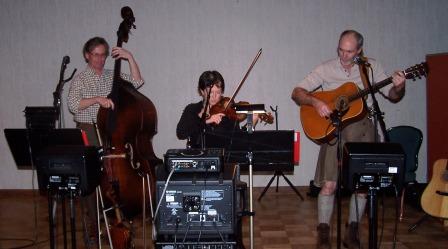 The dance begins: After the warmup marches, the Master of Ceremonies (MC) will invite the dancers to form sets. Sometimes, that will be preceded by the band playing eight bars or so of the lead tune for the upcoming dance. The MC will tell you what kind of set to form, and how many people should be in the set, and the name of the dance (i.e., “Please form four-couple longways sets for Campbell’s Frolic”). It helps to pay attention to the MC’s instructions so the sets can be formed quickly with minimal milling about. Sets should be formed by couples from the top of the room down. It is considered bad manners to cut in front of a couple already in the set, so new couples should join existing sets at the bottom. It is also frowned upon to join the set as a single dancer – one should ask another dancer to dance, then join as a couple. And who does the asking? Anyone! Men can ask ladies to dance, ladies can ask men, ladies can ask ladies, and (least common) men can ask men.
The dance begins: After the warmup marches, the Master of Ceremonies (MC) will invite the dancers to form sets. Sometimes, that will be preceded by the band playing eight bars or so of the lead tune for the upcoming dance. The MC will tell you what kind of set to form, and how many people should be in the set, and the name of the dance (i.e., “Please form four-couple longways sets for Campbell’s Frolic”). It helps to pay attention to the MC’s instructions so the sets can be formed quickly with minimal milling about. Sets should be formed by couples from the top of the room down. It is considered bad manners to cut in front of a couple already in the set, so new couples should join existing sets at the bottom. It is also frowned upon to join the set as a single dancer – one should ask another dancer to dance, then join as a couple. And who does the asking? Anyone! Men can ask ladies to dance, ladies can ask men, ladies can ask ladies, and (least common) men can ask men.
During the dance: In SCD, if you take the floor for a dance, it is best if you either know the dance, or are reasonably confident you can do the dance from a brief, or have been assured that your partner can “get you through it.” If you aren’t sure about a dance, or the program indicates the dance is recommended for experienced dancers only, consider sitting it out. If asked, responses like, “I’d like to sit this one out” or “Can I give you a rain check for a later dance?” are perfectly acceptable and often heard. AND, don’t let yourself be coerced on to the floor by the MC saying, “We need one more couple!” Many of us at some point in our dancing careers have identified “bathroom dances” on a ball program. (A “bathroom dance” is one where we you retreat to the bathroom until after the dance starts to avoid having to decline a request to dance or have your arm twisted into a dance you don’t feel up to.) And on that note, it helps to familiarize yourself somewhat with the program before the dance starts. You don’t have to memorize the program or every dance, and no one will be upset if you make a mistake on the floor (we all do), but it will help if you have an idea of what dances you might want to sit out and know when they are coming up. The ball program is often posted on the walls of the dance hall, and will be in that booklet of dance briefs you may have gotten on arrival, so occasionally checking either will help you keep track of what is coming next. If in doubt about whether you should attempt a dance on an upcoming program, ask your teacher. In North American SCD, the common practice is to give a verbal recap, or “brief,” of a dance before it starts. On rare occasions, for obscure or especially difficult dances, the dance may be walked through once before it is danced. However, this is the exception to common practice and will likely only happen once or twice on a ball program, if at all. Dancers should stand quietly in sets and listen to the briefing. After the briefing, the band will play a chord for dancers to bow or curtsy to their partners and the dance will begin. After the dance is over, there will be another chord for bow and curtsy, and normal practice is to thank your partner and others in the set for the dance and wait until the band plays or the MC announces the next dance before forming new sets.
Mistakes: Everybody makes them. When (not if) you make a mistake in a dance, just smile and do your best to get to where you need to be to start the next phrase or round of the dance. If anyone criticizes you for making a mistake, they are the one in the wrong, not you! If you find yourself lost, it will help to keep your head up and look at your partner or the other dancers in the set. If they are experienced dancers and good at helping others, they will give you subtle, preferably nonverbal, cues as to what comes next and/or where you need to be. If all else fails, go to the position you will be in at the end of this round of the dance and wait for the next round to start. If that fails, drop to the bottom of the set and wait there for the new top couple to start
the next round of the dance.
The Inviolable Rule of SCD: If you aren’t having fun, you aren’t doing it right. Just relax and enjoy the great music and good company! This is a social event, not a performance!
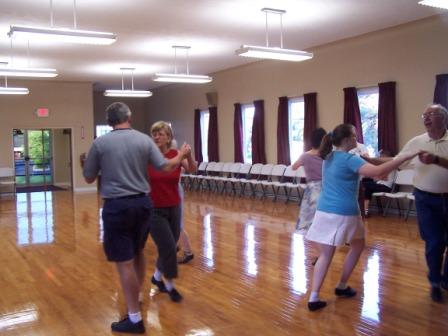
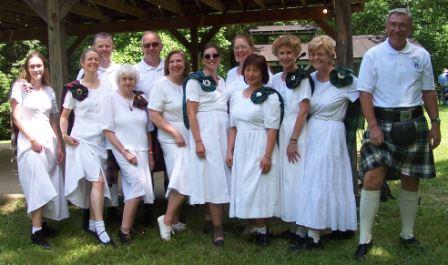

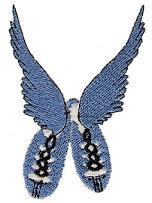 The Swelterin’ Strathspey
The Swelterin’ Strathspey 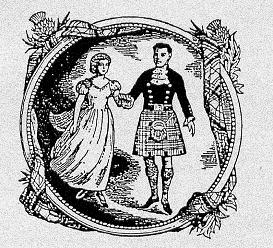 The July 28th Jig
The July 28th Jig  The dance begins: After the warmup marches, the Master of Ceremonies (MC) will invite the dancers to form sets. Sometimes, that will be preceded by the band playing eight bars or so of the lead tune for the upcoming dance. The MC will tell you what kind of set to form, and how many people should be in the set, and the name of the dance (i.e., “Please form four-couple longways sets for Campbell’s Frolic”). It helps to pay attention to the MC’s instructions so the sets can be formed quickly with minimal milling about. Sets should be formed by couples from the top of the room down. It is considered bad manners to cut in front of a couple already in the set, so new couples should join existing sets at the bottom. It is also frowned upon to join the set as a single dancer – one should ask another dancer to dance, then join as a couple. And who does the asking? Anyone! Men can ask ladies to dance, ladies can ask men, ladies can ask ladies, and (least common) men can ask men.
The dance begins: After the warmup marches, the Master of Ceremonies (MC) will invite the dancers to form sets. Sometimes, that will be preceded by the band playing eight bars or so of the lead tune for the upcoming dance. The MC will tell you what kind of set to form, and how many people should be in the set, and the name of the dance (i.e., “Please form four-couple longways sets for Campbell’s Frolic”). It helps to pay attention to the MC’s instructions so the sets can be formed quickly with minimal milling about. Sets should be formed by couples from the top of the room down. It is considered bad manners to cut in front of a couple already in the set, so new couples should join existing sets at the bottom. It is also frowned upon to join the set as a single dancer – one should ask another dancer to dance, then join as a couple. And who does the asking? Anyone! Men can ask ladies to dance, ladies can ask men, ladies can ask ladies, and (least common) men can ask men.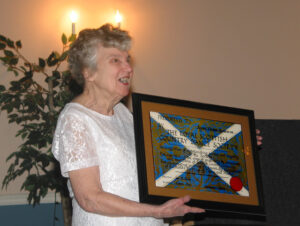
 Nora was a 2003 recipient of a Scroll of Honour in recognition of her many years of service and outstanding loyalty to the RSCDS, for her contributions in preserving the standards and traditions of Scottish country dancing, and for her joyous encouragement of young and old alike to increase their knowledge and enjoyment of Scotland’s heritage of dance and music.
Nora was a 2003 recipient of a Scroll of Honour in recognition of her many years of service and outstanding loyalty to the RSCDS, for her contributions in preserving the standards and traditions of Scottish country dancing, and for her joyous encouragement of young and old alike to increase their knowledge and enjoyment of Scotland’s heritage of dance and music.